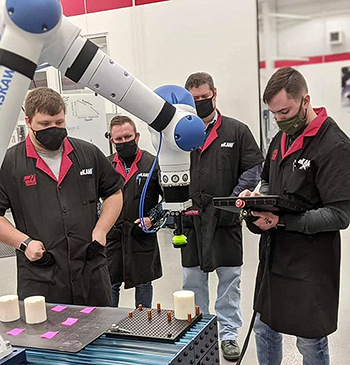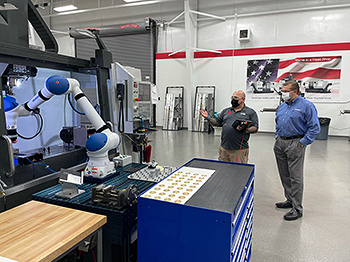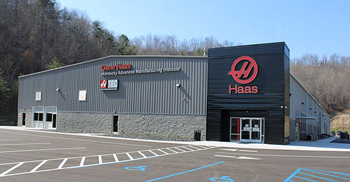 Thanks to Industry 4.0 and the rapid pace of technological change, job responsibilities continue to evolve, and the primary capabilities needed to fulfill manufacturing and warehousing tasks are shifting as a result. Moreover, advancements in automation and digitization are saturating the industrial landscape, creating a dichotomy between existing worker skill sets and the knowledge needed to operate robotic systems and advanced technologies.
Thanks to Industry 4.0 and the rapid pace of technological change, job responsibilities continue to evolve, and the primary capabilities needed to fulfill manufacturing and warehousing tasks are shifting as a result. Moreover, advancements in automation and digitization are saturating the industrial landscape, creating a dichotomy between existing worker skill sets and the knowledge needed to operate robotic systems and advanced technologies.
For these reasons, it is more important than ever to build an adaptive workforce trained in Industry 4.0 technologies. The National Association of Manufacturers (NAM) reports 71% of manufacturers find it increasingly harder to find skilled workers (2019). This reality, combined with the Advanced Robotics for Manufacturing (ARM) Institute’s prediction that 4.6 million manufacturing jobs will need to be filled in the United States over the next decade – with the prospect of 2.4 million of those going unfilled due to lack of training (2021) – is prompting manufacturers and educators to take strategic action.
To address talent gaps, customer demands and ongoing disruption, company leaders are implementing innovative tools, including highly capable yet easy-to-use robots, to improve operational efficiency and product quality. Excelling at dull, dirty, dangerous and difficult applications, robots work tirelessly to complete a multitude of jobs.
Employers understand that the effective and strategic use of high-performance robots can free workers from injury-prone tasks to perform higher value-added assignments, boosting employee morale and fostering hyper-productive work environments as a result. Thus, a growing number of manufacturers in nearly every industry are implementing flexible robots to ramp up production, create fluid supply chains and maintain competitive edge.
As expected, the utilization of robotic automation and its peripheral tools will also create major demand for entirely new careers including those in data analytics, autonomous systems, technology design, advanced machine programming and more. This is prompting an unwavering commitment to intertwine modern technology and dedicated resources with learning opportunities. Furthermore, unique manufacturing partnerships are being formed to focus on talent recruitment, training and deployment – with the end goal of provid transformative results that foster future success on both private and public levels.
Solution
 To adequately prepare students for the utmost success in digital factory environments, educational institutions, such as the eKentucky Advanced Manufacturing Institute (eKAMI), a Haas Technical Education Center, continue to develop unique training models and course curricula that reflect the latest technology. Located in a 40,000 square-foot facility in Paintsville, Kentucky, eKAMI’s immersive programs are cultivating a 21st century manufacturing workforce for the Appalachian region.
To adequately prepare students for the utmost success in digital factory environments, educational institutions, such as the eKentucky Advanced Manufacturing Institute (eKAMI), a Haas Technical Education Center, continue to develop unique training models and course curricula that reflect the latest technology. Located in a 40,000 square-foot facility in Paintsville, Kentucky, eKAMI’s immersive programs are cultivating a 21st century manufacturing workforce for the Appalachian region.
Central to the institute’s mission of diversifying the region’s economy is its preparation of hard-working talent for advanced manufacturing jobs that align with industry standards. To provide direction about in-demand technical and soft skills, industry leaders from companies, such as FedEx, READY Robotics and Balluff, partner with eKAMI, offering professional insights. “Due to the continued labor shortage, many companies are transitioning to robots for computer numerical control (CNC) machine tending applications,” says Kathy Walker, eKAMI’s founder and CEO. “By providing hands-on robot training in conjunction with CNC operation at our facility, a person can walk away with the ability to manage several machines, greatly benefitting the manufacturers in our local community and beyond.”
All students are trained on state-of-the-art equipment, including Haas CNC machines and Yaskawa robots, to prepare for real world occupations and scenarios. “The flexible yet robust nature of Yaskawa’s HC10 collaborative robot makes it an excellent fit for the foundational skills we teach at eKAMI,” continues Walker. “Section one of the eKAMI curriculum is CNC machining, followed by phase two, which is robotics. The machine tending capability of the HC10 helps to expertly connect the two areas of study.”
Spanning in ages from 17 to 65, incoming eKAMI students possess a wide breadth of experience. From high school graduates to accomplished coal miners, two educational tracks are offered depending on skill capability. A full training program for unexperienced workers takes ten months to complete, and the upskilling pathway lasts five months. This highly specific training targets technical aspects of advanced manufacturing, as well as key soft skills such as punctuality, appearance, teamwork and personal finance. A key aspect of Manufacturing 5.0 – where STEM-based knowledge and human skills work cohesively with technology to reach top operational performance – this training is essential to many recruiters today.
Facilitating this high-tech education are other intuitive tools, such as READY Robotics’ Forge/OS 5 universal programming platform. Compatible with 250 robots from top original equipment manufacturers (OEMs), Forge/OS 5 enables manufacturers to learn one operating system (OS) to control different robot brands and other hardware, including high-performance Yaskawa robots. Easy-to-use peripherals like this provide a significant impact toward digital transformation, empowering a wider user group to learn and implement robotic automation on factory floors. Physical production environments can now quickly and easily accommodate frequent changeover for low-volume production runs, offering impressive versatility for basic assembly, material handling, machine tending and packaging tasks.
Results
 The jobs of yesterday are being reworked to accommodate advanced technologies. In a sense, students that possess the ability to adapt and deploy innovative tools are becoming the “bridge people” between the old way of doing things and the new. This pioneering spirit of “learning by doing” is clearing a path for others to follow. Moreover, manufacturers are taking note of the talent pool that is now available in Kentucky’s Appalachian region. Large OEMs, as well as small- to medium-sized manufacturers, are looking to build production facilities within the region and seeking to hire eKAMI graduates.
The jobs of yesterday are being reworked to accommodate advanced technologies. In a sense, students that possess the ability to adapt and deploy innovative tools are becoming the “bridge people” between the old way of doing things and the new. This pioneering spirit of “learning by doing” is clearing a path for others to follow. Moreover, manufacturers are taking note of the talent pool that is now available in Kentucky’s Appalachian region. Large OEMs, as well as small- to medium-sized manufacturers, are looking to build production facilities within the region and seeking to hire eKAMI graduates.
As innovations and methodologies shift the primary skills required to fulfill industrial tasks, job definitions will continue to evolve. Consequently, schools of every shape and size will clamor for industry input to hone their programs to maintain relevance in new fields of study that did not exist ten years ago or were relegated to a lab experiment. For this reason, flexible yet tech-targeted educational models, like eKAMI’s, are crucial to maintaining a high level of enthusiasm for STEM-centric programs and cultivating the workforce of the future. Hand-in-hand relationships between schools, manufacturers and government must exist and grow to support vocational education, where employability and hiring rates prevail as the final judge of any successful or scholastic effort.
Full case study article originally published in Techniques.